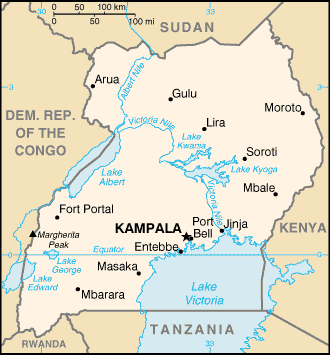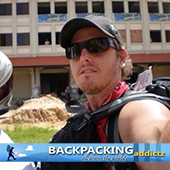- Population: 27.6 million (UN, 2005)
- Capital: Kampala
- Area: 241,038 sq km (93,072 sq miles)
- Major languages: English (official), Swahili, Ganda, various Bantu languages
- Major religions: Christianity, Islam
- Life expectancy: 46 years (men), 47 years (women) (UN)
- Monetary unit: 1 Ugandan shilling = 100 cents
Backpacking in Uganda
The Republic of Uganda is Winston Churchill’s “pearl of Africa” and while the natural surroundings are distinctively stunning, this is no ordinary African safari. Although Rwanda has made a rep for their mountain gorillas and the Sigourney Weaver promotion, Uganda has the highest concentration of primates on earth, evidently of the mountain gorillas, the main jewels of Uganda. However, mention of Uganda and the outside world reckons “The Last King of Scotland” Idi Amin instantly, who has been dead since 2003. But getting over his tyranny is a mighty feat just because the country has not progressed significantly as it should. Surely, it has acquired some stability since Amin, but not sufficient to take pride in. The plague of poverty, disease, and mortality haunts what could be the great nation of Uganda which has got lots to boot and lots more to boast of its people and places.
But, the world of tourism it promotes is detached to the reality of the country’s condition, albeit travel guides write otherwise. The country is in a grave and deep national crisis the Ugandans acknowledge. Travelling to the land of primates isn’t just some fun expedition with flowers and gorillas on trees. The Ugandans are at a critical moment, add the chaos of conflicting people, and of traditions and modernity, the near future remains uncertain. While conflict deters visitors from heading to this direction of Sub-Saharan Africa, to be a conscious traveller would mean visiting to help the local communities and the preservation of the gorillas. And as the numbers of tourists decrease, luckily, the traveller can delight in an exclusive gorilla safari with plenty of room to breathe and move.
GEOGRAPHY
Uganda (1 00 N, 32 00 E), in Eastern Africa, is a landlocked country of 241,038 km2 of thickly forested land, 70% approximately. Inland, 12% of the terrain is swampy due to interior water supply from lakes and rivers resulting to fertile and irrigated lands. The country is mostly plateau as the whole country is 621m above sea level, the lowest being Lake Albert (621 m). Uganda is rimmed with mountain ranges, the highest in Africa, the Mountains of the Moon, and the highest point is Margherita Peak standing at 5,110m above sea. Uganda is also the source of the grand Nile.
CLIMATE
Although the climate is tropical, the climate varies with altitude. Generally, with an equatorial/tropical climate, there are two dry seasons, first, from December-February, then, from June-August. On the northeast particularly, the climate is semiarid.
PEOPLE
To date, there are 33,398,682 Ugandans living in the country, with the lot of the population densest in the southern regions of the country. The Baganda is the largest ethnic group covering around 18% of the total population, but Uganda is home to many more groups (Banyankole, Bahima, Bakiga, Banyarwanda, Bunyoro, Batoro, Langi, Acholi, Lugbara, Karamojong, Basoga, Bagisu, and others), none so much more or less than the other really. Uganda is known to be 2nd in the world for the highest birth rate and fertility in women (6.73 babies to ever Ugandan woman). Also, 940,000 of the population are blighted with AIDS.
LANGUAGE
There around 40 languages in use in the country, however, ENGLISH is the official language taught in schools and utilized in several forms of media and political processes such as court. LUGANDA is the vernacular in urban areas like Kampala, while SWAHILI is approved as the nation’s official second language, and is generally spoken only among the Ugandan military with close relation to Amin’s declaration of Swahili as the national language during his time. ARABIC is also spoken by a minority.
RELIGION
The census lists 85% of Uganda’s population are Christians and only 12% are Muslims. The remainder adhere to traditions and indigenous beliefs, Judaism, and Baha’i. These traditional beliefs are amongst the biggest concerns of oddly enough, modernized Uganda and many other African countries for that matter. Child sacrifice, female genitalia mutilation (FGM), and albino genocide are part of traditional beliefs which are just a sick and confused premise that one’s blood and suffering is the benefit and progress of another.
ATTRACTIONS
Lush green forests, majestic lakes and rivers, marvellous wildlife…Uganda’s got them as well as run-down shacks and dying people, and in this aspect, this becomes the quintessential Africa we’d all come to know. Still in conflict, tourism has quite become a hard sell, the chief industry that supports local communities and wildlife. The Bwindi Impenetrable National Park, a UNESCO World Heritage Site,is a great place to track the endangered mountain gorillas. Join an hour of gorilla safari for 60 minutes and watch generations of gorillas living in one space in the forest. Only this goes for a maximum of strictly 8 people, which must already include the rangers in the count, so as not to stress them.
The grand Lake Victoria also offers the unique Ugandan wildlife diversity (add the benefit of thick forest covers as your natural sunscreen). But, as there can only be so much sightseeing and game watching to be done, rafting on the Nile, or quad-biking off it are less mundane options. While there is the hustle and bustle of the metropolitan of Kampala that while teems with mighty buildings and sophistication and, unfortunately reeks of gas fumes, Entebbe is a far cry from the fast-paced life at the capital where a day drifts slowly with the birds sing pleasantries while the chimp rustles leaves in percussion.
FOOD
But the people are the best bit of travelling to Uganda. Without a trace of abhorrence and trauma, they are generous and game for either a feast or friendly football match. I prefer the latter, because the Ugandan spread is enticing and delectable, especially after a trek in the Rwenzori National Park. The staples vary depending on region. It could be plantains, cassava, sweet potatoes, corn, millet, and rice-something different every time, in every place in Uganda. Ugali is special and good but after having that in 10 or so African countries, Ugandan culinary diversity is a breath of fresh air, and relief. We’re also talking fish, chicken and beef done many “amazing ways” ways. Fried, they are succulent and in stews, full-bodied. The toasted sandwiches, chapattis, and samosas are also good snacks to go, for the true blue adventurer, some delicacy perhaps? Nsenene or nswaa, white ant or grasshopper, you figure out which is what.
***





